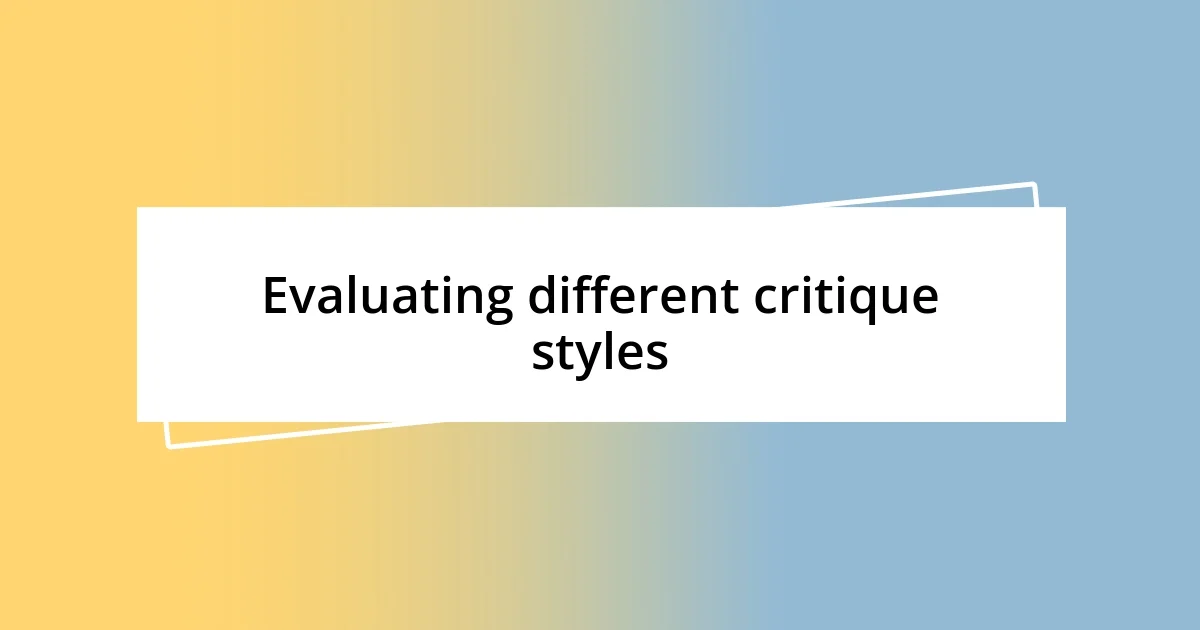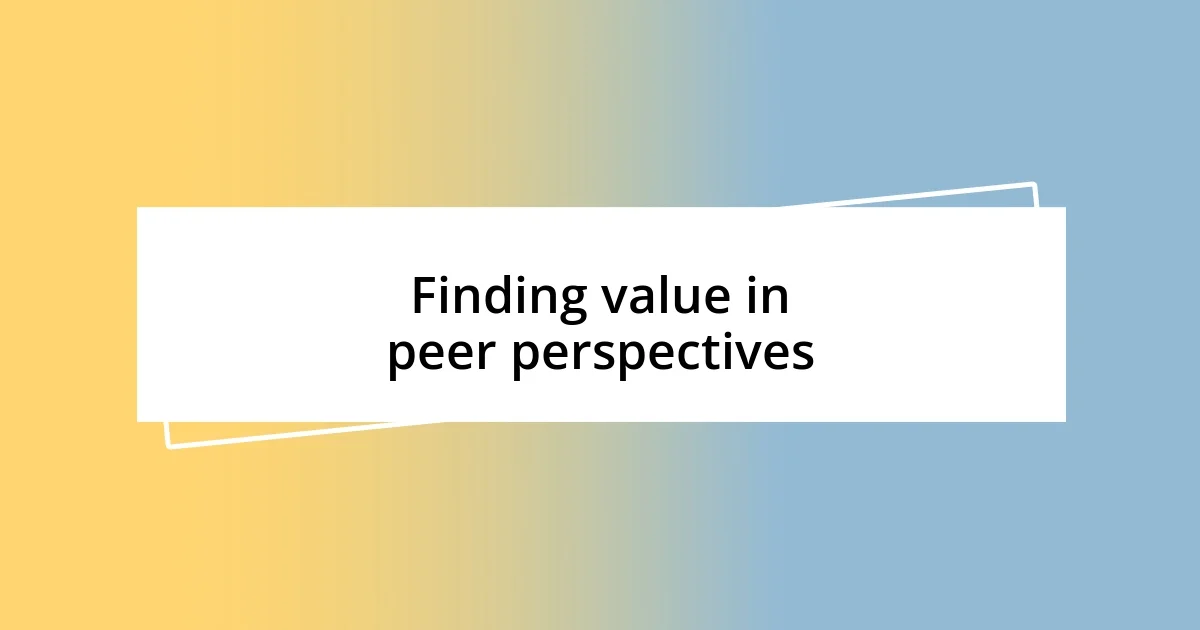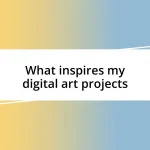Key takeaways:
- Critiques are essential for artistic growth, fostering dialogue and providing fresh perspectives that enhance creativity.
- Constructive feedback focuses on specific improvements and encourages actionable suggestions, while non-constructive feedback can be vague or overly harsh.
- Developing a personal critique process includes self-reflection, documenting insights, and engaging with emotions to turn criticism into a constructive growth experience.

Understanding the purpose of critiques
Critiques serve as a vital tool for growth in any artistic journey. I remember my first experience receiving feedback on a painting I poured my heart into. At that moment, I felt vulnerable, but the constructive criticism I received allowed me to see the work from a fresh perspective, helping me elevate my craft.
Understanding the purpose behind critiques is essential. They’re not just about pointing out flaws; they aim to ignite meaningful dialogue and foster deeper connections between the artist and their audience. When a fellow artist pointed out the lighting issues in my photography, it struck me that this feedback wasn’t an attack but a means to enhance the emotional impact of my work.
Through critiques, we glean insights that might otherwise go unnoticed. Have you ever found yourself blinded by your own artistic vision? I certainly have. It’s from these exchanges that we realize the value of different viewpoints, pushing us toward artistic development and resilience.

Identifying constructive feedback
Identifying constructive feedback can sometimes feel like searching for a needle in a haystack. When I started receiving critiques, I often felt overwhelmed by the sheer volume of opinions. However, I learned that constructive feedback typically focuses on specific aspects of the work rather than general impressions. For instance, when an instructor pointed out how a stroke in my painting could better convey movement, it opened my eyes to the power of precise critiques that enhance rather than discourage.
As I navigated through various critiques, I began to notice a pattern. Constructive feedback often includes actionable suggestions rather than just negative observations. I recall a time when a peer suggested altering the color palette in my mural to create a more harmonious atmosphere. This kind of guidance is not only helpful; it empowers artists to make meaningful changes that resonate with their vision and intent.
In contrast, feedback that lacks constructive elements can be vague or overly harsh. Once, a critic mentioned they didn’t like my piece without providing insight into what specifically bothered them. This left me feeling disheartened and confused. So, it’s important to cultivate the ability to sift through the noise and embrace critiques that offer genuine value, paving the way for growth and creativity in our artistic pursuits.
| Constructive Feedback | Non-Constructive Feedback |
|---|---|
| Specific and actionable | Vague and general |
| Focuses on improvement | Emphasizes flaws |
| Encourages dialogue | Shuts down conversation |

Evaluating different critique styles
Understanding the variety of critique styles can drastically influence an artist’s growth. I have encountered such a range—some critiques felt like a warm hug, while others seemed like a cold splash of water. In a particularly enlightening session, a mentor focused on the emotional essence of my work, encouraging me to dig deeper into my motivations. This approach not only validated my feelings but also pushed me to explore those emotions more thoroughly in my art.
Here are some examples of different critique styles I’ve experienced:
- Supportive and Encouraging: These critiques point out strengths while gently suggesting areas for improvement, creating a safe space for growth.
- Analytical and Technical: Focused on the elements and principles of design, they break down the artwork methodically—something I sometimes found overwhelming, yet ultimately beneficial.
- Direct and Honest: While they may feel harsh at first, direct critiques can lead to profound revelations, sparking a moment of true reflection in my artistic process.
- Collaborative and Conversational: These engage in a back-and-forth dialogue, allowing for a shared exploration of ideas and perspectives, which I find incredibly enriching and inspiring.

Applying feedback to improve work
Receiving feedback can feel like a double-edged sword—on one side, there’s the sting of criticism, and on the other, an opportunity for growth. I remember a critique session where a colleague highlighted the need for better composition in my piece. At first, it felt frustrating because I was emotionally attached to every detail. But once I took a step back, I realized that applying their insights helped transform my work into something more cohesive and engaging. It’s a powerful reminder that sometimes, stepping outside your comfort zone can lead to remarkable improvements.
When I actively apply feedback, I make it a point to document the suggestions that resonate with me. One time, a mentor suggested I experiment with varying textures in my artwork. Initially, I didn’t see how it would fit with my style. Yet, after trying it out, I found that incorporating different materials injected a fresh energy into my creations. This not only affirmed the value of constructive input but also reignited my passion for experimentation in my art.
I often ask myself: How can I take this feedback and run with it? This question has pushed me to view critiques as catalysts for innovation. Recently, after receiving feedback on the narrative depth of my work, I delved into storytelling elements, enriching my pieces in ways I hadn’t previously considered. The experience was both daunting and exhilarating, reminding me that applying feedback isn’t just about making changes; it’s about evolving as an artist and embracing every layer of the creative journey.

Finding value in peer perspectives
Finding value in peer perspectives often feels like uncovering hidden treasures within my artistic journey. There have been times when a fellow artist’s observation opened my eyes to aspects of my work I had never considered. For instance, after sharing my latest painting at a group critique, one peer pointed out how the color palette evoked a certain mood that I hadn’t intended. It made me curious—what else was I subconsciously communicating through my art?
What strikes me most is how different perspectives can highlight nuances in my work that I may overlook. I once had a conversation with an artist who specialized in abstract forms. Their insights on the emotional resonance of simplicity sparked a new approach in my own creations. It’s astounding how a single comment can shift your thinking and push you beyond your comfort zone, isn’t it? It reminds me of the importance of remaining open to feedback, as each interaction can lead to a breakthrough moment.
Embracing peer feedback not only enriches my artistic skills but also fosters a sense of community among artists. I remember a critique session where everyone shared their unique interpretations of each other’s pieces. It felt like a collaborative celebration rather than a judgmental evaluation. Through those shared experiences, I’ve learned that engaging with different viewpoints can enhance my work significantly. So, how can we create more of these enriching dialogues in our practices? For me, this question inspires continual exploration and connection within the vibrant world of art.

Overcoming challenges in criticism
Criticism can feel intimidating, but I’ve found it’s crucial to embrace those moments of discomfort. I recall a time when a critique left me feeling exposed—one artist bluntly questioned my thematic choices. Initially, I was defensive, but I took a moment to reflect. That inquiry spurred a deeper exploration into my motivations, ultimately making my narrative more compelling. The experience taught me that challenges in criticism often reveal the areas that need the most attention.
Navigating conflicting feedback can also be daunting. I once received two vastly different opinions on a project. One artist loved my color choices, while another viewed them as overwhelming. I felt torn, unsure which direction to pursue. Instead of succumbing to confusion, I learned to see these comments as constructive dialogue. I experimented with balancing the hues, refining my palette to satisfy both viewpoints. This taught me a valuable lesson: sometimes, the best path forward lies in synthesizing diverse insights.
At times, I’ve experienced the fear of losing my unique voice in the process of adapting to criticism. I remember submitting a piece that was well-received for its adherence to formal techniques, yet I felt it lacked my personal touch. That tug-of-war—between gaining accolades and remaining authentic—was eye-opening. It prompted me to ask, “How can I incorporate feedback without sacrificing my individuality?” By leaning into my artistic instincts while applying suggestions, I discovered a way to honor both my style and the insights gained from critiques. This balance is what continues to drive my growth as an artist.

Developing a personal critique process
Developing my personal critique process has been a journey of self-discovery and evolution. I remember the first time I sat down to assess my work honestly; it felt vulnerable yet empowering. I asked myself, “What do I genuinely want to say with this piece?” This introspective question set the stage for a more profound exploration of my artistic intentions. It became clear that understanding my voice helped me navigate the feedback I received from others, allowing me to filter critiques through the lens of my creative vision.
Over time, I discovered the importance of documenting my critiques for future reference. I started maintaining a journal where I jot down observations, feelings, and thoughts after each critique session. This practice became invaluable! I often flip back through those pages to remind myself of lessons learned. For instance, after a critique on a mixed media piece, I noted the suggestion to explore texture more deeply. A few months later, revisiting that note led me to develop a new technique that added dimension to my art. It was like having a conversation with my past self, guiding my growth.
I also realized that engaging with my emotions during this process is essential. After a particularly harsh criticism, I would sit with the feelings that came up—anger, confusion, or even sadness—before moving forward. I often ask myself, “What is this feedback really teaching me?” This question allows me to turn discomfort into a constructive experience. Instead of discarding criticism, I’ve learned to absorb it, reflect, and let it inform my next steps. Have you ever paused to feel your emotions before responding to critique? That simple act has transformed how I approach growth as an artist, breathing life into the oft-intimidating process of receiving feedback.














